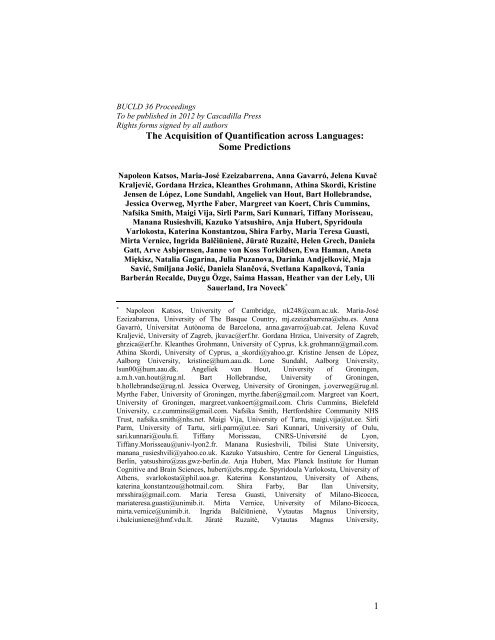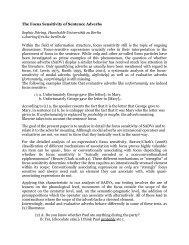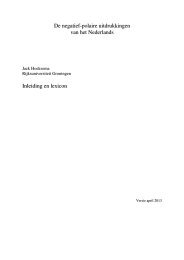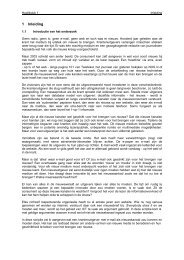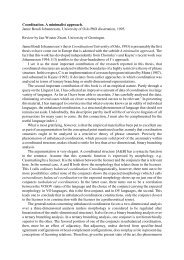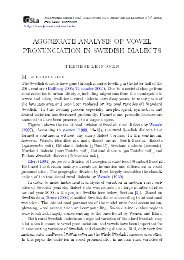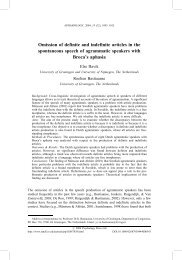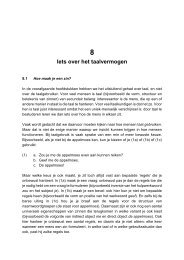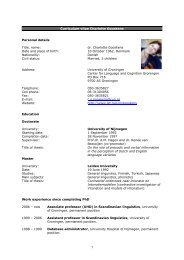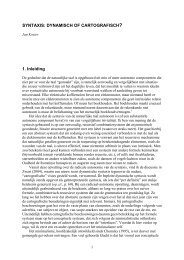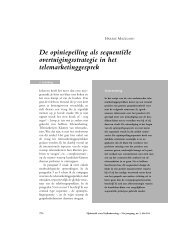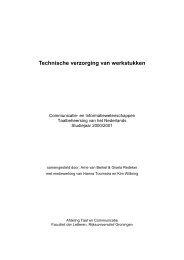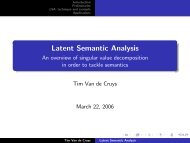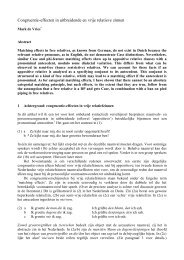Quantification in Spanish-speaking Children with Language ...
Quantification in Spanish-speaking Children with Language ...
Quantification in Spanish-speaking Children with Language ...
You also want an ePaper? Increase the reach of your titles
YUMPU automatically turns print PDFs into web optimized ePapers that Google loves.
BUCLD 36 Proceed<strong>in</strong>gs<br />
To be published <strong>in</strong> 2012 by Cascadilla Press<br />
Rights forms signed by all authors<br />
The Acquisition of <strong>Quantification</strong> across <strong>Language</strong>s:<br />
Some Predictions<br />
Napoleon Katsos, Maria-José Ezeizabarrena, Anna Gavarró, Jelena Kuvač<br />
Kraljević, Gordana Hrzica, Kleanthes Grohmann, Ath<strong>in</strong>a Skordi, Krist<strong>in</strong>e<br />
Jensen de López, Lone Sundahl, Angeliek van Hout, Bart Hollebrandse,<br />
Jessica Overweg, Myrthe Faber, Margreet van Koert, Chris Cumm<strong>in</strong>s,<br />
Nafsika Smith, Maigi Vija, Sirli Parm, Sari Kunnari, Tiffany Morisseau,<br />
Manana Rusieshvili, Kazuko Yatsushiro, Anja Hubert, Spyridoula<br />
Varlokosta, Kater<strong>in</strong>a Konstantzou, Shira Farby, Maria Teresa Guasti,<br />
Mirta Vernice, Ingrida Balčiūnienė, Jūratė Ruzaitė, Helen Grech, Daniela<br />
Gatt, Arve Asbjørnsen, Janne von Koss Torkildsen, Ewa Haman, Aneta<br />
Miękisz, Natalia Gagar<strong>in</strong>a, Julia Puzanova, Dar<strong>in</strong>ka Andjelković, Maja<br />
Savić, Smiljana Jošić, Daniela Slančová, Svetlana Kapalková, Tania<br />
Barberán Recalde, Duygu Özge, Saima Hassan, Heather van der Lely, Uli<br />
Sauerland, Ira Noveck ∗<br />
∗ Napoleon Katsos, University of Cambridge, nk248@cam.ac.uk. Maria-José<br />
Ezeizabarrena, University of The Basque Country, mj.ezeizabarrena@ehu.es. Anna<br />
Gavarró, Universitat Autònoma de Barcelona, anna.gavarro@uab.cat. Jelena Kuvač<br />
Kraljević, University of Zagreb, jkuvac@erf.hr. Gordana Hrzica, University of Zagreb,<br />
ghrzica@erf.hr. Kleanthes Grohmann, University of Cyprus, k.k.grohmann@gmail.com.<br />
Ath<strong>in</strong>a Skordi, University of Cyprus, a_skordi@yahoo.gr. Krist<strong>in</strong>e Jensen de López,<br />
Aalborg University, krist<strong>in</strong>e@hum.aau.dk. Lone Sundahl, Aalborg University,<br />
lsun00@hum.aau.dk. Angeliek van Hout, University of Gron<strong>in</strong>gen,<br />
a.m.h.van.hout@rug.nl. Bart Hollebrandse, University of Gron<strong>in</strong>gen,<br />
b.hollebrandse@rug.nl. Jessica Overweg, University of Gron<strong>in</strong>gen, j.overweg@rug.nl.<br />
Myrthe Faber, University of Gron<strong>in</strong>gen, myrthe.faber@gmail.com. Margreet van Koert,<br />
University of Gron<strong>in</strong>gen, margreet.vankoert@gmail.com. Chris Cumm<strong>in</strong>s, Bielefeld<br />
University, c.r.cumm<strong>in</strong>s@gmail.com. Nafsika Smith, Hertfordshire Community NHS<br />
Trust, nafsika.smith@nhs.net. Maigi Vija, University of Tartu, maigi.vija@ut.ee. Sirli<br />
Parm, University of Tartu, sirli.parm@ut.ee. Sari Kunnari, University of Oulu,<br />
sari.kunnari@oulu.fi. Tiffany Morisseau, CNRS-Université de Lyon,<br />
Tiffany.Morisseau@univ-lyon2.fr. Manana Rusieshvili, Tbilisi State University,<br />
manana_rusieshvili@yahoo.co.uk. Kazuko Yatsushiro, Centre for General L<strong>in</strong>guistics,<br />
Berl<strong>in</strong>, yatsushiro@zas.gwz-berl<strong>in</strong>.de. Anja Hubert, Max Planck Institute for Human<br />
Cognitive and Bra<strong>in</strong> Sciences, hubert@cbs.mpg.de. Spyridoula Varlokosta, University of<br />
Athens, svarlokosta@phil.uoa.gr. Kater<strong>in</strong>a Konstantzou, University of Athens,<br />
kater<strong>in</strong>a_konstantzou@hotmail.com. Shira Farby, Bar Ilan University,<br />
mrsshira@gmail.com. Maria Teresa Guasti, University of Milano-Bicocca,<br />
mariateresa.guasti@unimib.it. Mirta Vernice, University of Milano-Bicocca,<br />
mirta.vernice@unimib.it. Ingrida Balčiūnienė, Vytautas Magnus University,<br />
i.balciuniene@hmf.vdu.lt. Jūratė Ruzaitė, Vytautas Magnus University,<br />
1
1. Introduction<br />
In this paper we review factors that are expected to affect the order of<br />
acquisition of quantifiers across languages. We draw a dist<strong>in</strong>ction between<br />
language-wide and language-specific factors as well as factors that relate to the<br />
biological and social profile of the learner (such as gender, socio-economic<br />
status and school<strong>in</strong>g). We then propose predictions for what cross-l<strong>in</strong>guistically<br />
similar patterns may arise. This exposition provides the theoretical background<br />
aga<strong>in</strong>st which a major empirical project has been undertaken, <strong>with</strong> the goal of<br />
document<strong>in</strong>g the extent to which the acquisition of quantifiers proceeds<br />
uniformly across languages. Here we summarize the scope of the project, the<br />
specific hypotheses under test, and other factors that must be considered <strong>in</strong><br />
analys<strong>in</strong>g the outcome of the ongo<strong>in</strong>g empirical work. We conclude by<br />
discuss<strong>in</strong>g the implications of these <strong>in</strong>vestigations for the <strong>in</strong>terface between<br />
l<strong>in</strong>guistic and non-l<strong>in</strong>guistic cognition. But first we turn to cross-l<strong>in</strong>guistic<br />
similarities <strong>in</strong> the mean<strong>in</strong>g of quantifiers <strong>in</strong> the follow<strong>in</strong>g section.<br />
2. <strong>Quantification</strong>: cross-l<strong>in</strong>guistic similarities and differences<br />
<strong>Quantification</strong>al expressions allow us to precisely express generalizations.<br />
For example, the generic ‘Dogs like to chase cats’ turns <strong>in</strong>to a much more<br />
precise claim when we change the subject to ‘some dogs’, ‘all dogs’, or ‘most<br />
dogs’. The mean<strong>in</strong>g of these quantifiers is traditionally taken to correspond to<br />
set-theoretical logical concepts (among others see Barwise & Cooper, 1981;<br />
j.ruzaite@hmf.vdu.lt. Helen Grech, University of Malta, helen.grech@um.edu.mt.<br />
Daniela Gatt, University of Malta, daniela.gatt@um.edu.mt. Arve Asbjørnsen, University<br />
of Bergen, Arve.Asbjornsen@psybp.uib.no. Janne von Koss Torkildsen, University of<br />
Bergen, Norway, janne.torkildsen@psybp.uib.no. Ewa Haman, University of Warsaw,<br />
meh@psych.uw.edu.pl. Aneta Miękisz, University of Warsaw, amiekisz@gmail.com.<br />
Natalia Gagar<strong>in</strong>a, Centre for General L<strong>in</strong>guistics, Berl<strong>in</strong>, gagar<strong>in</strong>a@zas.gwz-berl<strong>in</strong>.de.<br />
Julia Puzanova, Herzen State Pedagogical University of Russia, j.puzanova@gmail.com.<br />
Dar<strong>in</strong>ka Andjelković, University of Belgrade, dandjelk@f.bg.ac.rs. Maja Savić,<br />
University of Belgrade, smaya@eunet.rs. Smiljana Jošić, University of Belgrade,<br />
smiljana.josic@gmail.com. Daniela Slančová, Prešov University,<br />
daniela.slancova@unipo.sk. Svetlana Kapalková, Comenius University,<br />
kapalkova@fedu.uniba.sk. Tania Barberán Recalde, University of The Basque Country,<br />
tania.barberan@hotmail.com Duygu Özge, Koç University, dozge@ku.edu.tr. Saima<br />
Hassan, International Islamic University, Islamabad, cyma_h@hotmail.com. Heather van<br />
der Lely, Harvard University, hvdlely@wjh.harvard.edu. Uli Sauerland, Centre for<br />
General L<strong>in</strong>guistics, Berl<strong>in</strong>, uli@alum.mit.edu. Ira Noveck, CNRS-Université de Lyon,<br />
noveck@isc.cnrs.fr. The research reported <strong>in</strong> this paper was supported by fund<strong>in</strong>g from<br />
COST Action A33 ‘Cross-l<strong>in</strong>guistically robust stages of children’s l<strong>in</strong>guistic<br />
performance’, http://www.zas.gwz-berl<strong>in</strong>.de/<strong>in</strong>dex.php?id=47&L=1 (chair: Uli<br />
Sauerland; vice-chair: Heather van der Lely).<br />
2
Gamut, 1991). For example, the mean<strong>in</strong>g of the English quantifiers ‘all’ and<br />
‘some’ is considered to be equivalent to that of the universal and existential<br />
quantifier (‘∀’ and ‘∃’) and the truth-conditions of quantified sentences are<br />
given us<strong>in</strong>g set-theoretical tools as <strong>in</strong> (1), where ‘iff’ is ‘if and only if’, ‘∩’ is<br />
the <strong>in</strong>tersection of two sets, ‘∅’ is the empty set, and a is an element of a set:<br />
1. (a) ‘All As are Bs’ is true iff A ∩ B = A<br />
(b) ‘Some As are Bs’ is true iff A ∩ B ≠ ∅<br />
(c) ‘No As are Bs’ is true iff A ∩ B = ∅<br />
(d) ‘Some As are not Bs’ is true iff there exists a, such that a ∈ A and a<br />
∉ B<br />
(e) ‘Most As are Bs’ is true iff A ∩ B > |A – B|<br />
Recent typological research <strong>in</strong> semantics suggests that most human<br />
languages conta<strong>in</strong> these and other quantifiers, though it is debated whether <strong>in</strong><br />
fact all of them do (Matthewson, 2004). However, for the languages that do have<br />
universal, existential, and other quantifiers, it is reported that the mean<strong>in</strong>g of<br />
these quantifiers exhibits strik<strong>in</strong>g similarities cross-l<strong>in</strong>guistically (von F<strong>in</strong>tel &<br />
Matthewson, 2008).<br />
The similarities <strong>in</strong> the mean<strong>in</strong>g of quantifiers extend to their actual use. For<br />
example, speakers are required not only to be truthful, but also to be <strong>in</strong>formative<br />
up to a contextually dictated level: speakers should not describe a situation for<br />
which they know that all the apples are <strong>in</strong> the boxes by say<strong>in</strong>g that ‘some of the<br />
apples are <strong>in</strong> the boxes’. Even though the sentence would be strictly speak<strong>in</strong>g<br />
true of that situation, the speaker would be violat<strong>in</strong>g conversational norms that<br />
enjo<strong>in</strong> him not to be under-<strong>in</strong>formative. Such pragmatic considerations are<br />
founded on pr<strong>in</strong>ciples of human rationality (Grice, 1989) or cognitive economy<br />
and cost–benefit optimisation <strong>in</strong> the exchange of <strong>in</strong>formation (for different<br />
approaches see Lev<strong>in</strong>son, 2000; Sperber & Wilson, 1986/1995). Cross-l<strong>in</strong>guistic<br />
<strong>in</strong>vestigations suggest that pragmatic maxims are at play <strong>in</strong> every human<br />
language, <strong>with</strong> <strong>in</strong>formativeness be<strong>in</strong>g the flagship example (for refutation of<br />
early claims to the contrary see Pr<strong>in</strong>ce, 1982).<br />
These cross-l<strong>in</strong>guistic similarities <strong>in</strong> the mean<strong>in</strong>g and use of quantifiers are<br />
exactly what one would expect if, across languages, these quantifiers are <strong>in</strong>deed<br />
the l<strong>in</strong>guistic counterparts of the same set of abstract concepts. Therefore, the<br />
mean<strong>in</strong>g and conventions of use of these expressions are to some significant<br />
extent <strong>in</strong>dependent of the specific grammatical and lexical configuration of<br />
particular languages.<br />
On the other hand, the lexical and syntactic realization of logical vocabulary<br />
<strong>in</strong> general, and quantifiers <strong>in</strong> particular, differs substantially from language to<br />
language. Regard<strong>in</strong>g lexical differences, some languages have specialized words<br />
<strong>with</strong> the dedicated function of express<strong>in</strong>g quantity, while others recruit<br />
expressions from the class of common nouns. A good case <strong>in</strong> po<strong>in</strong>t is the<br />
proportional quantifier which is often expressed cross-l<strong>in</strong>guistically through a<br />
3
quantificational determ<strong>in</strong>er or an adjective (e.g. English ‘most’, a determ<strong>in</strong>er,<br />
and <strong>in</strong> German ‘die meisten’, an adjective). However, <strong>in</strong> many languages<br />
proportional quantifiers are formed through nom<strong>in</strong>alizations which yield<br />
expressions mean<strong>in</strong>g ‘a majority of’ or ‘the biggest part’ (for example, French,<br />
<strong>Spanish</strong>, and Russian; von F<strong>in</strong>tel & Matthewson, 2008). As an example of<br />
syntactic variation, languages differ <strong>in</strong> concord <strong>with</strong> negation: while <strong>in</strong> standard<br />
British English a s<strong>in</strong>gle negative quantifier suffices to express negation, ‘None<br />
of the apples are <strong>in</strong> the boxes’, other languages use two negative markers, a<br />
negative quantifier and a negative particle, e.g. French, ‘Aucune pomme n’est<br />
dans le boites’. Double negation <strong>in</strong> these cases does not correspond to a positive<br />
statement (as it would be the case for English ‘No apples are not <strong>in</strong> the boxes’).<br />
Instead, the mean<strong>in</strong>g is similar to that of the English s<strong>in</strong>gle negative. Other<br />
lexical and syntactic features that vary across languages <strong>in</strong>clude the order of the<br />
elements <strong>with</strong><strong>in</strong> the quantify<strong>in</strong>g phrase (quantifier–noun order or the reverse)<br />
and whether a partitive expression can be used (e.g. ‘some of the’) among<br />
others.<br />
Quantifiers therefore pose an <strong>in</strong>terest<strong>in</strong>g case at the <strong>in</strong>terface between<br />
language-specific and language-general cognition. For speakers to know the<br />
mean<strong>in</strong>g of quantifiers, and to know how to use them felicitously, they must<br />
master set-theoretical concepts and pr<strong>in</strong>ciples of rational <strong>in</strong>formation exchange<br />
that seem to be <strong>in</strong>dependent of the specific language that they are speak<strong>in</strong>g.<br />
However, they must also be competent <strong>with</strong> the way the relevant language<br />
<strong>in</strong>stantiates quantifier mean<strong>in</strong>g and syntax.<br />
In this paper we explore how language-wide similarities <strong>in</strong> mean<strong>in</strong>g and<br />
use, and language-specific lexical and syntactic choices, may give rise to<br />
consistent patterns of acquisition across a large sample of languages. Quantifiers<br />
are an ideal test-bed to study this, precisely because their comprehension<br />
<strong>in</strong>volves both the lexico-syntactic choices <strong>in</strong> the particular languages and the<br />
cross-l<strong>in</strong>guistically robust similarities <strong>in</strong> mean<strong>in</strong>g and use. This exploration is<br />
the theoretical background to an ongo<strong>in</strong>g empirical project on the acquisition of<br />
‘all’, ‘some’, ‘none’, ‘some…not’, and ‘most’ by 5-year-old children speak<strong>in</strong>g<br />
one of 25 languages. The language sample for the empirical project, which<br />
represents 10 major language groups (as well as a language isolate), provides a<br />
wide range of syntactic and lexical diversity that allows us to <strong>in</strong>vestigate any<br />
effects of language-specific choices.<br />
3. The empirical sett<strong>in</strong>g<br />
As part of the larger project of COST Action A33 (see acknowledgements<br />
footnote), the empirical <strong>in</strong>vestigation focuses on the comprehension of<br />
quantified sentences by 5-year-old children and adults speak<strong>in</strong>g one of 25<br />
languages: Basque, Catalan, Croatian, Cypriot Greek, Danish, Dutch, English,<br />
Estonian, F<strong>in</strong>nish, French, Georgian, German, Standard Greek, Hebrew, Italian,<br />
Lithuanian, Maltese, Norwegian, Polish, Russian, Serbian, Slovak, <strong>Spanish</strong>,<br />
Turkish, and Urdu. These represent ten major language groups (Baltic, F<strong>in</strong>nic,<br />
4
Georgian, Germanic, Greek, Indic, Romance, Semitic, Slavic, and Turkic),<br />
belong<strong>in</strong>g to five of the ma<strong>in</strong> language families <strong>in</strong> the world (Afro-Asiatic,<br />
Altaic, Indo-European, Kartvelian and Uralic/F<strong>in</strong>no-Ugric) as well as a<br />
language-isolate (Basque).<br />
<strong>Children</strong> are be<strong>in</strong>g tested at nurseries or primary schools follow<strong>in</strong>g the<br />
ethical protocols designated by the host <strong>in</strong>stitutions of the participat<strong>in</strong>g<br />
researchers. They will be adm<strong>in</strong>istered the ‘Cavegirl task’ (see Katsos et al.,<br />
2011, for a full list of items and task <strong>in</strong>formation) which was designed to test the<br />
comprehension of quantified sentences. In this task participants are help<strong>in</strong>g a<br />
fictional cartoon character, the Cavegirl, to learn to speak their own language.<br />
They hear the Cavegirl produce utterances of the type ‘[Quantifier] of the<br />
[objects] are <strong>in</strong> the boxes’ for each of the quantifiers <strong>in</strong> (1). After each utterance,<br />
children are asked to evaluate whether what the Cavegirl said was “right” or<br />
“wrong”, given a visually represented situation. If participants answer “wrong”,<br />
they are further asked to tell the Cavegirl why the utterance was wrong. This is<br />
done to check whether participants were evaluat<strong>in</strong>g the utterances on the<br />
grounds of the quantity mentioned or not (e.g. other research has documented<br />
that populations <strong>with</strong> developmental disorders may occasionally reject<br />
utterances on unrelated grounds, e.g. ‘Bicycles don’t fit <strong>in</strong> boxes’).<br />
There are two types of visual situations for each quantifier, one which<br />
renders an utterance <strong>with</strong> this quantifier logically true and <strong>in</strong>formative and one<br />
which renders an utterance logically false. For quantifiers ‘some’, ‘some…not’,<br />
and ‘most’ there is also a third type of display that renders an utterance logically<br />
true but pragmatically under-<strong>in</strong>formative (for ‘some’ and ‘most’ this is a display<br />
where all of objects mentioned are <strong>in</strong>side the boxes; for ‘some…not’ this is a<br />
display where none of the objects mentioned are <strong>in</strong>side the boxes). The task is<br />
preceded by a warm-up session where children are familiarised <strong>with</strong> the<br />
Cavegirl, the task demands, and the pictures of the objects mentioned <strong>in</strong> the<br />
sentences.<br />
The actual quantifiers used <strong>in</strong> each language were selected by researchers<br />
who were native speakers of that language. Where more than one lexical item<br />
was available, the choice was predom<strong>in</strong>antly guided by consider<strong>in</strong>g which item<br />
would be most familiar to children of the age-group. Where possible, this<br />
decision was <strong>in</strong>formed by <strong>in</strong>vestigat<strong>in</strong>g corpora of child-directed speech. Where<br />
not, researchers took a decision after consultation <strong>with</strong> colleagues and/or schoolteachers.<br />
Adult participants were also tested to ensure that the quantifiers chosen<br />
were <strong>in</strong>deed true, false or under-<strong>in</strong>formative for the respective visual displays as<br />
hypothesized.<br />
4. Developmental predictions<br />
4.1. Predictions based on similarities <strong>in</strong> mean<strong>in</strong>g and use<br />
Let us first turn to predictions relat<strong>in</strong>g to cross-l<strong>in</strong>guistic similarities <strong>in</strong> the<br />
mean<strong>in</strong>g and use of quantifiers. Previous s<strong>in</strong>gle-language studies document that<br />
differences <strong>in</strong> the mean<strong>in</strong>g and use of quantifiers lead to measurable effects at<br />
5
the neurological (Troiani, Peelle, Clark & Grossman, 2009) and behavioral level<br />
for adult process<strong>in</strong>g (among many others, Cumm<strong>in</strong>s & Katsos, 2010; Hackl,<br />
2009; Szymanik & Zajenkowski, 2010) and for child acquisition (e.g., Hanlon,<br />
1988; Katsos, Andrés Roqueta, Estevan & Cumm<strong>in</strong>s, 2011). Based on these<br />
studies, the follow<strong>in</strong>g hypotheses can be deduced from the mean<strong>in</strong>g of the<br />
specific expressions that we study.<br />
Hypothesis 1 relates to polarity and the fact that negation is a l<strong>in</strong>guistically<br />
and psychol<strong>in</strong>guistically marked function (Just & Carpenter, 1971). We could<br />
therefore expect that children’s rates of successful comprehension will be higher<br />
<strong>with</strong> positive quantifiers (‘all’, ‘some’) than negative ones (‘none’,<br />
‘some…not’).<br />
Hypothesis 2 relates to totality and the fact that quantifiers whose reference<br />
set is the maximum possible set appear earlier <strong>in</strong> acquisition over quantifiers<br />
whose reference set is a portion of the potential reference set (Hanlon, 1988).<br />
We could therefore expect that children’s rates of successful comprehension will<br />
be higher <strong>with</strong> universal (‘all’, ‘none’) than existential quantifiers (‘some’,<br />
‘some…not’).<br />
Hypothesis 3 relates to semantic complexity and the fact that while both<br />
‘some’ and ‘most’ refer to an under-specified portion of the total, ‘most’<br />
stipulates an additional constra<strong>in</strong>t, namely that this portion be more than half (<strong>in</strong><br />
fact the mean<strong>in</strong>g of ‘most’ is likely to be richer than ‘more than half’, but this<br />
rough paraphrase suffices for stat<strong>in</strong>g this hypothesis; see Hackl, 2009; Pietroski,<br />
Lidz, Hunter, & Halberda, 2009). It is expected that children’s rates of<br />
successful comprehension will be higher <strong>with</strong> existential ‘some’ than<br />
proportional ‘most’.<br />
Turn<strong>in</strong>g to the use of quantifiers, our f<strong>in</strong>al hypothesis, 4, relates to<br />
<strong>in</strong>formativeness and truth. Young children seem to make extensive use of<br />
pragmatic pr<strong>in</strong>ciples for word learn<strong>in</strong>g and disambiguation (Clark, 1990), and<br />
they are also aware that under- and over-<strong>in</strong>formative utterances are not optimal<br />
(Davies & Katsos, 2010; Katsos & Bishop, 2011; Katsos & Smith, 2010).<br />
Nevertheless young children do not consider violations of <strong>in</strong>formativeness to be<br />
as grave as violations of logical truth, and do not categorically reject under<strong>in</strong>formative<br />
utterances (e.g., Guasti, Chierchia, Cra<strong>in</strong>, Foppolo, Gualm<strong>in</strong>i &<br />
Meroni, 2005; Noveck, 2001; Papafragou & Musol<strong>in</strong>o, 2003). We could<br />
therefore expect children’s rates of successful comprehension to be higher <strong>with</strong><br />
true-and-<strong>in</strong>formative or patently false utterances than <strong>with</strong> true-but-under<strong>in</strong>formative<br />
utterances (for ‘some’, ‘some…not’, and ‘most’).<br />
Crucially, the prediction is that the four patterns described above will obta<strong>in</strong><br />
<strong>in</strong> every language <strong>in</strong> our sample, precisely because these patterns rely on crossl<strong>in</strong>guistically<br />
similar properties of the mean<strong>in</strong>g and use of quantifiers.<br />
4.2. Predictions based on language-specific features<br />
Moreover, it is likely that language-specific lexical and syntactic properties<br />
of quantified utterances will affect the pattern of acquisition. For example, <strong>in</strong><br />
6
terms of syntax, it is possible that negative concord, the word order <strong>with</strong><strong>in</strong> the<br />
quantifier phrase, and the word order of the sentence will have an impact on<br />
comprehension. However, it is not necessarily clear what the direction of the<br />
<strong>in</strong>fluence will be <strong>in</strong> each case (as we are not aware of research that could help<br />
predict whether, for <strong>in</strong>stance, the quantifier–restrictor order is easier to acquire<br />
than the <strong>in</strong>verse).<br />
In terms of the lexicon, it is possible that us<strong>in</strong>g an expression from a<br />
specialised class of quantifiers may favourably impact acquisition because of the<br />
close paradigmatic relations <strong>with</strong><strong>in</strong> the class. For example, it may be easier to<br />
master the mean<strong>in</strong>g of English ‘most’ than French ‘la plupart’ or <strong>Spanish</strong> ‘la<br />
mayoría’ because ‘most’ belongs to the paradigm of quantifiers which <strong>in</strong>cludes<br />
‘all’, ‘none’, and ‘some’. Contrasts between members of the paradigm may<br />
therefore facilitate the acquisition of their mean<strong>in</strong>g. These contrasts may be less<br />
salient <strong>in</strong> languages employ<strong>in</strong>g an expression from a different class. It is also<br />
possible that the number of syllables of each expression is an important factor.<br />
However, as <strong>with</strong> many of the syntactic factors reviewed above, we are not<br />
aware of relevant research that could bear on these hypotheses, and so it is an<br />
open question whether these factors will turn out to be significant predictors of<br />
children’s performance. F<strong>in</strong>ally, another potentially important factor may be the<br />
explicit presence of a partitive marker (like English ‘of the’), which may<br />
positively affect children’s performance <strong>with</strong> under-<strong>in</strong>formative utterances<br />
(Pouscoulous, Noveck, Politzer & Bastide, 2007; but see Banga, Heut<strong>in</strong>ck,<br />
Berends & Hendriks, 2009).<br />
4.3. Predictions based on biological and social properties of the population<br />
F<strong>in</strong>ally, a range of non-l<strong>in</strong>guistic factors may also be important predictors of<br />
the acquisition of quantifiers. These <strong>in</strong>clude social factors, such as children’s<br />
socio-economic background, and whether they are attend<strong>in</strong>g school at the time<br />
of test<strong>in</strong>g. From a biological perspective, exact age and gender may also have a<br />
role. As regards gender, it is reported that l<strong>in</strong>guistic skills are generally better<br />
among females than among males, even <strong>in</strong> children as young as 2–3 years<br />
(Bornste<strong>in</strong>, Haynes, Pa<strong>in</strong>ter, & Genevro, 2000; Dionne, Dale, Boiv<strong>in</strong>, & Plom<strong>in</strong>,<br />
2003) <strong>with</strong> girls beg<strong>in</strong>n<strong>in</strong>g to talk earlier (Murray, Johnson, & Peters, 1990), and<br />
to acquire vocabulary faster (Roulstone, Loader, & Northstone, 2002). Some of<br />
these differences may be attributed to neurological differences <strong>in</strong> how language<br />
is processed (Burman, Bitan, & Booth, 2008). On the other hand, it has been<br />
suggested that males may outperform females when it comes to reason<strong>in</strong>g <strong>with</strong><br />
mathematical concepts, due to higher aptitude <strong>with</strong> logical and set-theoretical<br />
concepts (though for a critical review see Spelke, 2005).<br />
To the extent that these gender differences are <strong>in</strong>deed valid, quantification<br />
seems to be a case where the gender biases compete aga<strong>in</strong>st each other. On the<br />
one hand, females may benefit from an overall advantage <strong>with</strong> learn<strong>in</strong>g<br />
vocabulary, while on the other hand males may benefit from an advantage <strong>with</strong><br />
set-theoretical concepts. A further <strong>in</strong>terest<strong>in</strong>g prediction relates to Hypothesis 4<br />
7
of the language-wide predictions, on the ability to detect violations of<br />
<strong>in</strong>formativeness. It has recently been reported that differences <strong>in</strong> cognitive style,<br />
and specifically the prevalence of autistic features <strong>with</strong><strong>in</strong> the neuro-typical<br />
population, predicts sensitivity to Gricean pragmatic pr<strong>in</strong>ciples. Nieuwland,<br />
Ditman & Kuperberg (2010) reported that participants’ scores <strong>in</strong> the<br />
Communication subscale of the Autism Quotient (Baron-Cohen, Wheelright,<br />
Sk<strong>in</strong>ner, Mart<strong>in</strong> & Clubley, 2001), a measure which quantifies the prevalence of<br />
autistic traits, correlated <strong>with</strong> ERPs to utterances that violated the maxim of<br />
<strong>in</strong>formativeness. Participants <strong>with</strong> high scores <strong>in</strong> the Autism Quotient<br />
(<strong>in</strong>dicat<strong>in</strong>g stronger presence of autistic traits) showed weaker N400 effects,<br />
<strong>in</strong>dicat<strong>in</strong>g that they were not as sensitive to under<strong>in</strong>formativeness as participants<br />
<strong>with</strong> lower scores. Given that the prevalence of autistic traits <strong>in</strong> higher <strong>with</strong><strong>in</strong> the<br />
male population at large, it is therefore possible that sensitivity to violations of<br />
<strong>in</strong>formativeness will be attenuated <strong>in</strong> boys compared to girls.<br />
5. Discussion<br />
When completed, the present study will provide a rich array of crossl<strong>in</strong>guistic<br />
data enabl<strong>in</strong>g us to evaluate the hypotheses presented <strong>in</strong> section 4.1,<br />
and to explore the significance of the additional factors touched upon <strong>in</strong> the<br />
above discussion. In this section, we briefly discuss the implications of future<br />
f<strong>in</strong>d<strong>in</strong>gs for our understand<strong>in</strong>g of the <strong>in</strong>terdependence of l<strong>in</strong>guistic and nonl<strong>in</strong>guistic<br />
cognition. We are particularly <strong>in</strong>terested <strong>in</strong> the four language-wide<br />
hypotheses. If the empirical <strong>in</strong>vestigation were to reveal that these patterns hold<br />
across every language <strong>in</strong> our sample one could be entitled to ask what is the<br />
underly<strong>in</strong>g foundation of these effects. A plausible response is that the languagewide<br />
similarities <strong>in</strong> aspects of quantifier mean<strong>in</strong>g and use are underp<strong>in</strong>ned by<br />
universal trends <strong>in</strong> the development of non-verbal cognition that may emerge at<br />
the pre-l<strong>in</strong>guistic stage. For example, the relative difficulty of negative<br />
quantifiers predicted <strong>in</strong> hypothesis 1 might be attributable to universal<br />
developmental trends <strong>in</strong> how and when child become aware of the presence as<br />
opposed to the absence of entities. Similarly, the relative process<strong>in</strong>g complexity<br />
of the non-l<strong>in</strong>guistic comparison of subsets that is required for the mean<strong>in</strong>g of<br />
‘most’, and the importance of children’s count<strong>in</strong>g skills (Halberda, Ta<strong>in</strong>g, &<br />
Lidz, 2008) may underl<strong>in</strong>e the effects of hypothesis 3; while a perceptual /<br />
conceptual advantage for identify<strong>in</strong>g the full membership of a set may underl<strong>in</strong>e<br />
the effects of totality <strong>in</strong> hypothesis 2. Perhaps the only case where a purely<br />
l<strong>in</strong>guistic explanation would be available is hypothesis 4, on children’s<br />
sensitivity to <strong>in</strong>formativeness. In this case, the cross-l<strong>in</strong>guistically universal<br />
difference between the gravity of violations of logical truth and of violations of<br />
conversational felicity (Katsos & Bishop, 2011) may suffice to account for any<br />
patterns that arise.<br />
Hav<strong>in</strong>g po<strong>in</strong>ted to a potential relation between the development of nonverbal<br />
cognition and competence <strong>with</strong> the correspond<strong>in</strong>g l<strong>in</strong>guistic expressions,<br />
it would be mislead<strong>in</strong>g to suggest that the direction of <strong>in</strong>fluence is uni-<br />
8
directional. Instead, research <strong>in</strong> related fields such as the acquisition of numerals<br />
suggests that <strong>in</strong> the absence of the l<strong>in</strong>guistic expressions of number (i.e. numeral<br />
words), the ability to reason <strong>with</strong> numerosities above the small range of the<br />
subitis<strong>in</strong>g numbers is restricted (see Spaepen, Coppola, Spelke, Carey, &<br />
Gold<strong>in</strong>-Meadow, 2011, and the discussion there<strong>in</strong>). As such, it is very likely that<br />
the acquisition of quantifiers feeds <strong>in</strong>to the development of the mastery of the<br />
correspond<strong>in</strong>g non-verbal set-theoretical concepts. It is therefore possible that<br />
the emerg<strong>in</strong>g picture will consider the relative contribution of l<strong>in</strong>guistic and nonl<strong>in</strong>guistic<br />
cognition to children’s overall competence <strong>with</strong> quantification, rather<br />
than identify<strong>in</strong>g one factor as be<strong>in</strong>g predom<strong>in</strong>ant.<br />
In fact some evidence that the acquisition of quantification is <strong>in</strong>deed<br />
<strong>in</strong>tegrally related to language development, and perhaps less so on the<br />
development of non-verbal cognition, is already available. Research suggests<br />
that competence <strong>with</strong> the mean<strong>in</strong>g and use of quantifiers is <strong>in</strong> fact related to<br />
children’s overall competence <strong>with</strong> vocabulary and grammar (Katsos et al.,<br />
2011; also Surian, Baron-Cohen & van der Lely, 1996) rather than <strong>in</strong> l<strong>in</strong>e <strong>with</strong><br />
their overall non-verbal IQ or social cognition. Studies <strong>in</strong> language disorders are<br />
particularly useful <strong>in</strong> cases where the relative contribution of different factors is<br />
under <strong>in</strong>vestigation. In the studies cited above, it has been found that children<br />
<strong>with</strong> language impairment who have age-appropriate non-verbal IQ, perform <strong>in</strong><br />
l<strong>in</strong>e <strong>with</strong> what would be expected based on their grammatical and lexical<br />
competence rather than their non-verbal IQ.<br />
This last f<strong>in</strong>d<strong>in</strong>g raises the possibility that competence <strong>with</strong> quantification<br />
may be a good <strong>in</strong>dicator of competence <strong>with</strong> grammar and vocabulary as a<br />
whole. If this is so, then quantifiers and other similar expressions may be used to<br />
develop benchmarks for assess<strong>in</strong>g a child’s language skills based on mean<strong>in</strong>g<br />
and use, rather than the traditional morphosyntactic criteria that are usually<br />
employed (e.g. <strong>in</strong> TROG, Bishop, 2003). The additional fact that benchmarks<br />
based on mean<strong>in</strong>g and use might be cross-l<strong>in</strong>guistically similar, allows for the<br />
possibility of a cross-l<strong>in</strong>guistically valid tool of language assessment.<br />
Obviously, the validity of several of the predictions and claims made <strong>in</strong> this<br />
paper will be tested through ongo<strong>in</strong>g and future empirical <strong>in</strong>vestigations.<br />
References<br />
Banga, Ar<strong>in</strong>a, Heut<strong>in</strong>ck, Ingeborg, Berends, Sanne M., & Hendriks, Petra. (2009). Some<br />
implicatures reveal semantic differences. In: Bert Botma & Jacquel<strong>in</strong>e van Kampen<br />
(Eds), L<strong>in</strong>guistics <strong>in</strong> the Netherlands 2009, John Benjam<strong>in</strong>s, Amsterdam, pp. 1-13.<br />
Baron-Cohen, Simon, Wheelwright, Sally, Sk<strong>in</strong>ner, Richard, Mart<strong>in</strong>, Joanne, & Clubley,<br />
Emma. (2001). Journal of Autism and Developmental Disorders, 31, 5–17.<br />
Barwise, Jon, & Cooper, Rob<strong>in</strong>. (1981). Generalized quantifiers and natural language.<br />
L<strong>in</strong>guistics and Philosophy, 4, 159-219.<br />
Bishop, Dorothy V. M. (2003). Test for Reception of Grammar Version 2, TROG 2<br />
manual. Harcourt Assessment, London.<br />
9
Bornste<strong>in</strong>, Marc H., Haynes, O. Maurice, Pa<strong>in</strong>ter, Kathleen M., & Genevro, Janice L.<br />
(2000). Child language <strong>with</strong> mother and <strong>with</strong> stranger at home and <strong>in</strong> the laboratory:<br />
A methodological study. Journal of Child <strong>Language</strong>, 27, 407-420.<br />
Burman, Douglas D., Bitan, Tali, & Booth, James R. (2008). Sex differences <strong>in</strong> neural<br />
process<strong>in</strong>g of language among children. Neuropsychologia, 46, 1349-1362.<br />
Clark, Eve V. (1990) On the pragmatics of contrast. Journal of Child <strong>Language</strong>, 17, 417-<br />
431.<br />
Dionne, G<strong>in</strong>ette, Dale, Philip S., Boiv<strong>in</strong>, Michel, & Plom<strong>in</strong>, Robert. (2003). Genetic<br />
evidence for bidirectional effects of early lexical and grammatical development.<br />
Child Development, 74, 394–412.<br />
Gamut, L. T. F. (1991). Logic, <strong>Language</strong> and Mean<strong>in</strong>g, volume 1 and 2. The University<br />
of Chicago Press.<br />
Grassmann, Susanne, Stracke, Marén, & Tomasello, Michael. (2009). Two-year-olds<br />
exclude novel objects as potential referents of novel words based on pragmatics.<br />
Cognition. 112, 488-493.<br />
Grice, Paul. (1989). Studies <strong>in</strong> the Way of Words, Harvard University Press, Cambridge<br />
MA.<br />
Guasti, Maria Teresa, Chierchia, Gennaro, Cra<strong>in</strong>, Stephen, Foppolo, Francesca,<br />
Gualm<strong>in</strong>i, Andrea, & Meroni, Luisa (2005). Why children and adults sometimes<br />
(but not always) compute implicatures. <strong>Language</strong> and Cognitive Processes, 20 (5):<br />
667-696.<br />
Hackl, Mart<strong>in</strong>. (2009). On the grammar and process<strong>in</strong>g of proportional quantifiers: Most<br />
versus more than half. Natural <strong>Language</strong> Semantics, 17(1), 63–98.<br />
Halberda, Just<strong>in</strong>, Ta<strong>in</strong>g, Len, & Lidz, Jeffrey. (2008). The development of ‘most’<br />
comprehension and its potential dependence on count<strong>in</strong>g-ability <strong>in</strong> preschoolers.<br />
<strong>Language</strong> Learn<strong>in</strong>g and Development, 4(2), 99-121.<br />
Hanlon, Camille. (1988). The emergence of set-relational quantifiers <strong>in</strong> early childhood.<br />
In Frank S. Kessel (Ed.), The development of language and language researchers:<br />
Essays <strong>in</strong> honor of Roger Brown. Hillsdale NJ: Erlbaum. 65-78.<br />
Just, Marcel Adam, & Carpenter, Patricia Ann. (1971). Comprehension of negation <strong>with</strong><br />
quantification. Journal of Verbal Learn<strong>in</strong>g and Verbal Behavior, 10, 244-253.<br />
Katsos, Napoleon, Andrés Roqueta, Clara, Clemente Estevan, Rosa Ana, & Cumm<strong>in</strong>s,<br />
Chris. (2011). Are children <strong>with</strong> Specific <strong>Language</strong> Impairment competent <strong>with</strong> the<br />
pragmatics and logic of quantification? Cognition, 119: 43-57.<br />
Katsos, Napoleon, & Bishop, Dorothy V. M. (2011). Pragmatic Tolerance: Implications<br />
for the Acquisition of Informativeness and Implicature. Cognition, 20: 67-81.<br />
Katsos, Napoleon, & Smith, Nafsika. (2010). Pragmatic Tolerance and Speaker-<br />
Comprehender Asymmetries. In Franich, Katie., Iserman, Kate M., and Keil,<br />
Lauren. L. (eds.), Proceed<strong>in</strong>gs of the 34th Annual Boston Conference <strong>in</strong> <strong>Language</strong><br />
Development. Cascadilla Press, MA, USA, pp 221-232.<br />
Lev<strong>in</strong>son, Stephen. (2000). Presumptive Mean<strong>in</strong>gs. Cambridge, Ma.: MIT Press.<br />
Murray, Ann D., Johnson, Jeanne, & Peters, Jo. (1990) F<strong>in</strong>e-tun<strong>in</strong>g of utterance length to<br />
preverbal <strong>in</strong>fants: Effects on later language development. Journal of Child<br />
<strong>Language</strong>, 17, 511–525.<br />
Nieuwland, Mante S., Ditman, Tali, & Kuperberg, G<strong>in</strong>a R. (2010). On the <strong>in</strong>crementality<br />
of pragmatic process<strong>in</strong>g: An ERP <strong>in</strong>vestigation of <strong>in</strong>formativeness and pragmatic<br />
abilities. Journal of Memory and <strong>Language</strong>, 63(3), 324–346.<br />
Noveck, Ira A. (2001). When children are more logical than adults. Cognition, 78, 165-<br />
188.<br />
10
Papafragou, Anna, & Schwarz, Naomi. (2005/6). Most wanted. <strong>Language</strong> Acquisition,<br />
13, 207-251.<br />
Pietroski, Paul, Lidz, Jeffrey, Hunter, Tim, & Halberda, Just<strong>in</strong>. (2009). The mean<strong>in</strong>g of<br />
‘most’: semantics, numerosity, and psychology. M<strong>in</strong>d and <strong>Language</strong>, 24(5), 554–<br />
585.<br />
Pouscoulous, Nausicaa, Noveck, Ira A., Politzer, Guy, & Bastide, Anne. (2007).<br />
Process<strong>in</strong>g costs and implicature development. <strong>Language</strong> Acquisition, 14, 347-376.<br />
Pr<strong>in</strong>ce, Ellen F. (1982). Grice and universality: A reappraisal.<br />
ftp://babel.l<strong>in</strong>g.upenn.edu/papers/faculty/ellen_pr<strong>in</strong>ce/grice.ps, ms University of<br />
Pennsylvania.<br />
Roulstone, Sue, Loader, Sue, & Northstone, Kate. (2002). Descriptive data from the<br />
Avon longitud<strong>in</strong>al study of parents and children. Early Child Development and<br />
Care, 22, 259–268.<br />
Spaepen, Elizabet, Coppola, Marie, Spelke, Elizabeth S., Carey, Susan E., & Gold<strong>in</strong>-<br />
Meadow, Susan. (2011). Number <strong>with</strong>out a language model. Proceed<strong>in</strong>gs of the<br />
National Academy of Sciences, 108(8), 3163-3168.<br />
Spelke, Elizabeth S. (2005). Sex differences <strong>in</strong> <strong>in</strong>tr<strong>in</strong>sic aptitude for mathematics and<br />
science: A critical review. American Psychologist, 60, 950-958.<br />
Sperber, Dan, & Wilson, Deirdre. (1986/1995). Relevance: Communication and<br />
Cognition. Oxford: Blackwell.<br />
Surian, Luca, Baron-Cohen, Simon, & van der Lely, Heather K. J. (1996). Are children<br />
<strong>with</strong> Autism deaf to Gricean Maxims? Cognitive Neuropsychiatry, 1, 55-71<br />
Szymanik, Jakub, & Zajenkowskim, Marc<strong>in</strong>. (2010) Comprehension of simple<br />
quantifiers. Empirical evaluation of a computational model, Cognitive Science,<br />
34(3), 521-532.<br />
Troiani,Vanessa, Peele, Jonathan E., Clark, Rob<strong>in</strong>, & Grossman, Murray. (2009) Is it<br />
logical to count on quantifiers? Dissociable neural networks underly<strong>in</strong>g numerical<br />
and logical quantifiers. Neuropsychologia, 47, 104-11.<br />
von F<strong>in</strong>tel, Kai, & Matthewson, Lisa. (2008). Universals <strong>in</strong> semantics. The L<strong>in</strong>guistic<br />
Review, 25(1-2), 139–201.<br />
11


